| Table of Contents | 1. Introduction 2. Comparison by Performance Indices ……. 2-1. Elasticity Indices ……. 2-2. Vibration Indices 3. Summary |
1. Introduction

Since 1996, ‘Primorac Carbon’ has been famous as a blade of extreme elasticity, although there has always been even faster blades such as Butterfly ‘Schlager OFF+’. Because of its high elasticity, we may be able to consider ‘Primorac Carbon’ as the blade for poly-ball. But, disregard of strong demand for faster blades, it seems that there aren’t many players who select extreme fast blades such as ‘Primorac Carbon’. Probably that is because the blade like ‘Primorac Carbon’ is expected to be too different from the blades those have been use by them. In general, the players whose main strategy is attack by spin don’t like hard feeling of ‘Primorac Carbon’ or similar blades from many other TT companies. And, the extreme high elasticity of ‘Primorac Carbon’ or similar blades is expected to give a bad influence on the balance of play. However, ironically ‘Primorac Carbon’ had actually been used by Zoran Primorac who is one of the most famous all-round players in the history of table tennis. And, Werner Schlager who is also a very famous all-round players had used ‘Schlager OFF+’ that is even harder and faster than ‘Primorac Carbon’. Differently speaking, if a player can be accustomed to that kind of blade, extreme high speed or hard feeling may be nothing.
While we are searching for the proper blade for ABS ball age, we’d better once examine the actual mechanical characteristics of so-called ‘Hinoki Carbon’ blades which is represented by ‘Primorac Carbon’.
Before examining the mechanical characteristics by Performance Indices, let’s briefly look around the construction and appearance of ‘Primorac Carbon’.

‘Primorac Carbon’ is a very thick blade. Its thickness is 6.8~7.0mm. It is thicker than most of fiber blades whose thickness is 5.5~6.0mm. The high elasticity of ‘Primorac Carbon’ is not only from carbon fiber but also from this thickness. There are 3 wood layers. Top layer is Hinoki, and center layer is Kiri. High density carbon fiber is inserted between center layer and top layers. The thickness of top layer is about 1.4mm, and that one layer is thicker than two layers (top layer + middle layer) of most of blades. Because top layer is very thick, the touch feel of Primorac Carbon is not as hard as we expect.

The handle or ‘Primorac Carbon’ is different from most of Butterfly blades. What you feel when you grip the handle of ‘Primorac Carbon’ for the first time will be that it is squared although the edge of handle is well rounded off.
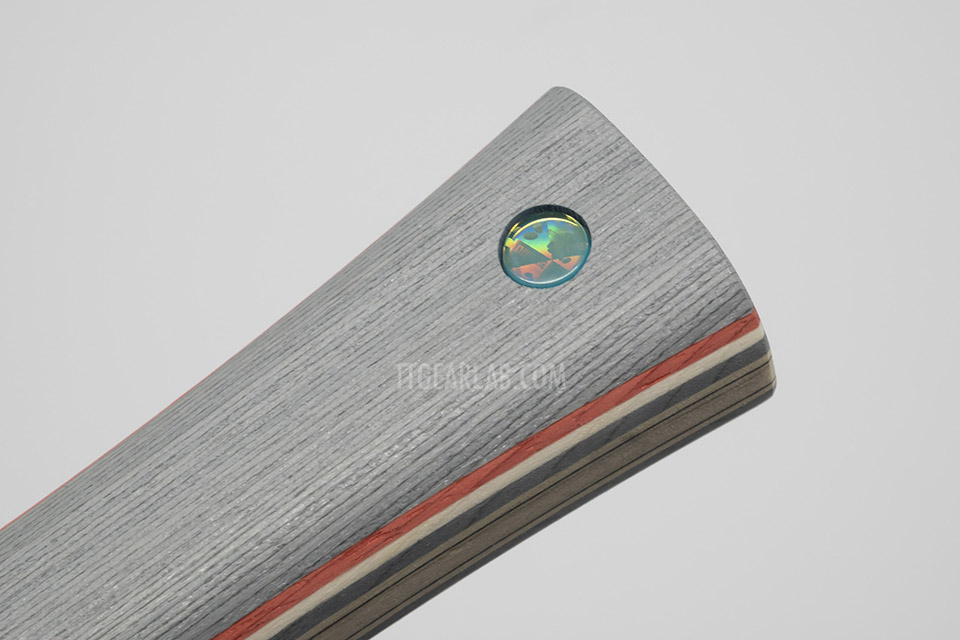
Since its introduction the design of ‘Primorac Carbon’ has been changed several times. The foreside lens has been changed two times. And, in 2014 the backside lens was replaced by small hologram lens. According to Butterfly, the hologram lens at the backside of lens is to distinguish Butterfly blades from imitated ones.
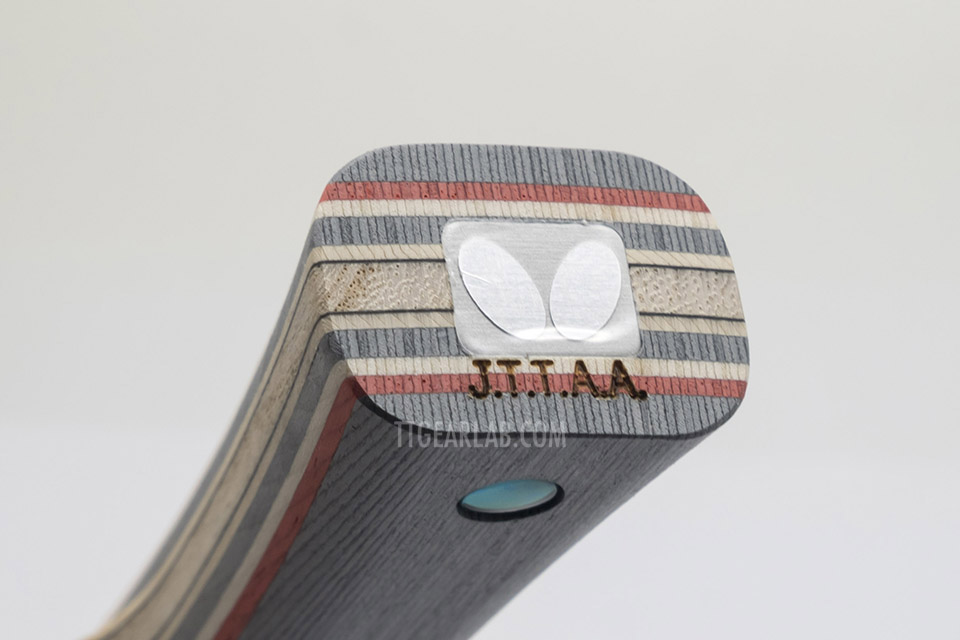
Logo plate at the end of handle was also changed in 2014 with the change of the C.I. of Butterfly. The end logo plate is the third version for ‘Primorac Carbon’.
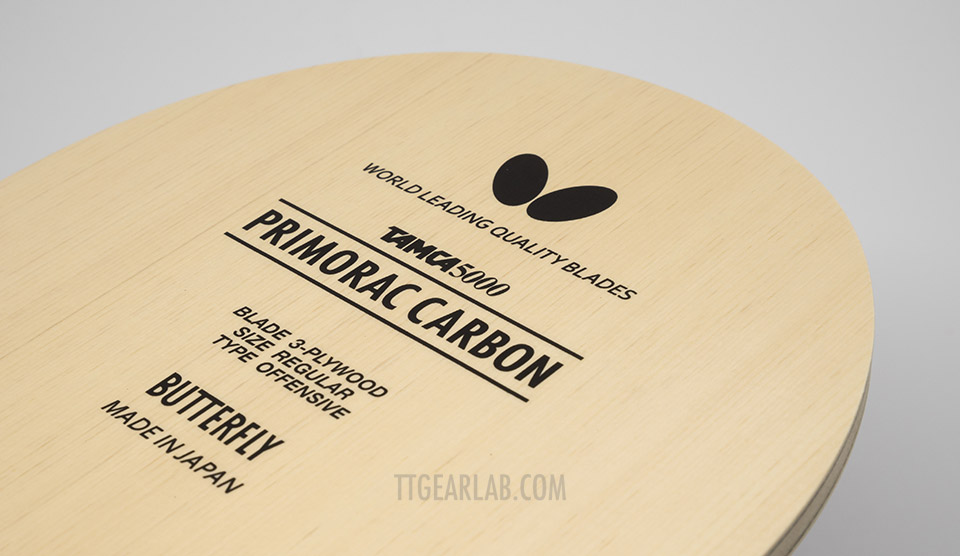
Foreside printing is also a new version from 2014. The players who has used ‘Primorac Carbon’ for long time may feel the new printing strange.

Then let’s observe the mechanical characteristics of ‘Primorac Carbon’ by Performance Indices.
Please click here to return to top (table of contents)
2. Comparison by Performance Indices
The blades to be compared are as follows :
- Stiga Carbonado 290 : The fastest fiber blade in current Stiga blade range
- Butterfly Timo Boll ALC : The representative of ALC (Arylate fiber + Carbon fiber) blades
- Butterfly Zhang Jike Super ZLC : The fastest model in Butterfly ‘Zhang Jike’ series
- Tibhar Kinetic Speed : Very fast ZLC blade which can be the rival of ‘Zhang Jike Super ZLC’
- Stiga ‘Clipper CR’ (heavy 7.0mm version) : The representative of thick 7-ply blades
- Tibhar CCA 7 : The rival of the thick/heavy ‘Clipper CR’
- Stiga Allround Classic : Reference (all values are 1.0)
‘Carbonado 290’ is the fastest blade in Stiga blade range. Its fiber is high-density TeXtreme which is a kind of woven carbon fiber which is much flatter than ordinary woven carbon fiber. Although TeXtreme is a carbon fiber, it is as soft as ALC.
‘Timo Boll ALC’ is the representative of ALC blades with outer-fiber construction. Although it isn’t an extreme fast blade, it can be considered as a quite fast blade.
‘Zhang Jike Super ZLC’ is a very fast blade. Although it will not be as fast as ‘Primorac Carbon’, it can be sufficiently comparable with ‘Primorac Carbon’.
‘Kinetic Speed’ is also a very fast blade. Its fiber is ZLC. (Probably it is similar to Super ZLC of ‘Zhang Jike Super ZLC’. Tibhar is calling the fiber just as ‘Hybrid ZC’.)
‘Clipper CR’ is the representative of 7-ply wood blades. Current version of ‘Clipper CR’ is much thinner and lighter than former version, and its elasticity is not that high. But, I selected old version of ‘Clipper CR’ whose thickness is about 7.0mm. (It is thicker by about 0.5mm than current version.) It is as fast as most of ‘outer-fiber’ blades, and is faster than most of ‘inner-fiber’ blades in the market. But, because of its thickness, it is a very heavy blade. (Its weight is about 95 gram, while the weight of current thinner version is 80~85 gram.)
‘CCA 7’ is also a very thick 7-ply wood blade. It is much thicker than other Tibhar 7-ply blades such as ‘Samsonov Force Pro Black Edition’ or new ‘Bernadette Szöcs Signature 1’. (I will deal with ‘Bernadette Szöcs Signature 1’ sooner or later.) ‘CCA 7’ can be compared with older version of ‘Clipper CR’ whose thickness is about 7.0mm that is also listed in this comparison.

Comparison will be done by performance indices. Concerning the detail of four performance indices, please refer to following articles in ‘Background’ section :
- Performance indices : the way to evaluate blade by measurement
- The example of comparison by performance indices
2-1. Elasticity Indices

The Ep of ‘Primorac Carbon’ is 2.97. The Ep close to 3.0 can be regarded as ‘extreme high’ elasticity. As we can expect from its thick construction with woven carbon fiber, ‘Primorac Carbon’ is an extremely elastic blade. The Ec of ‘Primorac Carbon’ is 2.69, and it is also a very high value, although it is relatively lower than Ep.
All blades in this comparison except for ‘Allround Classic’ are very fast or quite fast blades. But, any other blades in this comparison doesn’t show higher Ep or Ec than ‘Primorac Carbon’. The Ep of ‘Timo Boll ALC’ which is very popular blade is 2.14. That value looks very low when compared with the Ep of ‘Primorac Carbon’, although nobody will tell that ‘Timo Boll ALC’ isn’t a fast blade. The Ec of ‘Timo Boll ALC’ is even lower (= 1.77). When the players hits ball very hard, they will think that ‘Timo Boll ALC’ isn’ that elastic when compared with ‘Primorac Carbon’, because of its relatively lower value of Central Elasticity.
The one which is close to ‘Primorac Carbon’ is ‘Carbonado 290’. Although ‘Carbonado 290’ is much thinner than ‘Primorac Carbon’ (6.0mm vs. 7.0mm), its Ep is 2.71 which is not that lower than the Ep of ‘Primorac Carbon’. However, the Ep of ‘Carbonado 290’ (= 2.18) is noticeably lower than the Ep of ‘Primorac Carbon’. Therefore, players will feel fundamental difference between ‘Carbonado 290’ and ‘Primorac Carbon’ when they hit ball very hard. Some players will prefer the relatively high Ec of ‘Primorac Carbon’, and the others will prefer the relatively low Ec of ‘Carbonado 290’. It differs by the preference or the playing style of players. The values of ‘Zhang Jike Super ZLC’ is a bit lower than those of ‘Carbonado 290’. Therefore we will be able to tell the same story as ‘Carbonado 290’. ‘Zhang Jike Super ZLC’ is also a very fast blade. But, its center elasticity is much lower than that of ‘Primorac Carbon’. The player who tends to hit ball hard will be able to make good use of ‘Primorac Carbon’. (And, we can notice that ‘Carbonado 290’ can be the rival of ‘Zhang Jike Super ZLC’. Additionally, ‘Carbonado 190’ is the rival of ‘Timo Boll ALC’ although it isn’t included in this comparison.)
With Ep = 2.20, ‘Kinetic Speed’ isn’t as fast as ‘Carbonado 290’ and ‘Zhang Jike Super ZLC’ when we observe only Ep. However, we notice different story when we observe Ec. The Ec (= 2.15) of ‘Kinetic Speed’ is similar to those of ‘Carbonado 290’ and ‘Zhang Jike Super ZLC’. Therefore, hard hitters will feel that ‘Kinetic Speed’ gives same level of speed. But, if the players hit the ball more softly, ‘Kinetic Speed’ will give similar speed as ‘Timo Boll ALC’. Anyway, ‘Kinetic Speed’ is much less elastic than ‘Primorac Carbon’ in any case.
Then let’s observe the characteristics of thick/fast/heavy 7-ply wood blades. The Ep and Ec of ‘Clipper CR’ (older 7.0mm version) is 2.42 and 2.21 respectively. Those values are close to the values of ‘Zhang Jike Super ZLC’. But, because this one is thick & heavy version of ‘Clipper CR’, it is heavier than ‘Zhang Jike Super ZLC’. Some players will prefer the thickness and weight of ‘Clipper CR’ (7.0mm version). But, the others will prefer relatively thinner and lighter ‘Zhang Jike Super ZLC’. Because the Ep is relatively lower and the Ec is relatively higher than those of ‘Zhang Jike Super ZLC’ respectively, the shape of graph of ‘Clipper CR’ is more similar to that of ‘Primorac Carbon’ although the values of ‘Clipper CR’ are apparently lower. Because both of ‘Clipper CR’ and ‘Primorac Carbon’ are thick blades with similar thicknesses, and also because the shapes of the elasticity graphs of those two are similar with each other, the overall feel when players use those two blades is expected to be quite similar. If the players want to raise elasticity from thick ‘Clipper CR’, thick ‘Hinoki-Carbon’ blades such as ‘Primorac Carbon’ will be a good solution. And, if the players like ‘Primorac Carbon’ but want to reduce speed, thick 7-ply wood blades such as ‘Clipper CR’ will be a good solution.
‘CCA 7’ is less elastic than ‘Clipper CR’, with Ep = 2.04 and Ec = 1.94. That is because older thick version of ‘Clipper CR’ is used in this comparison. (If we compare ‘CCA 7’ with recent version of ‘Clipper CR’ which is much thinner and lighter, we will be able to notice that ‘CCA 7’ is noticeably faster than ‘Clipper CR’.) The primary elasticity is of ‘CCA 7’ is lower than that of ‘Timo Boll ALC’. But, the center elasticity of ‘CCA 7’ is higher than ‘Timo Boll ALC’. Although both of ‘CCA 7’ and ‘Timo Boll ALC’ are the blades for world’s top players, there exists noticeable difference between the characters of those two blades. The selection between two blades is concerned with the preference of individual player.
Examining Ec/Ep is an easier way to understand the tendency of elasticity of blades. Fig.10 shows the relationship between Ec/Ep and Ep.
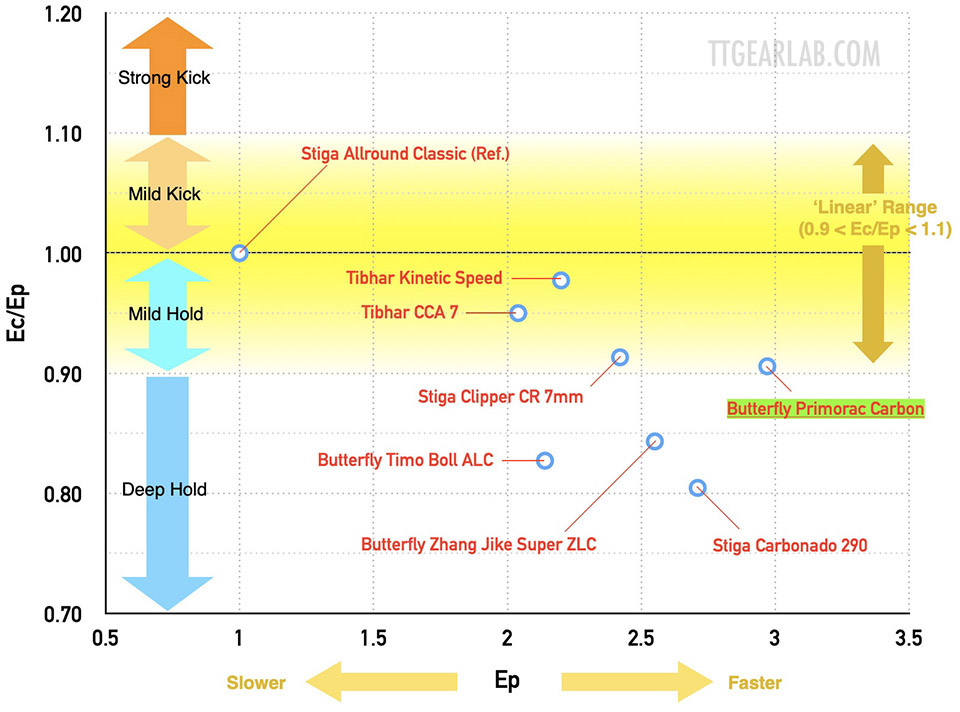
Ec/Ep expresses the ‘tendency’ of the elasticity of blade. By examining Ec/Ep and Ep at the same time, we can easily understand the behavior of blades.
On the graph, all the blades except for reference blade are in ‘Hold’ range (Ec/Ep < 1.0). ‘Primorac Carbon’ is also in ‘Hold’ range, i.e. the same range as many famous blades those are being used by many top players. It means that we don’t need to fear too much when we are considering to try ‘Primorac Carbon’. Probably what we should only concern is the extreme high Ep of ‘Primorac Carbon’.
From the graph, we can notice that the blade who gives the same level of Ec/Ep as ‘Primorac Carbon’ is ‘Clipper CR’ (thick/heavy version). Therefore we will be able to easily change between ‘Primorac Carbon’ and ‘Clipper CR’ while keeping the level of Hold/Kick characteristics. If we just pay attention to the difference of elasticity, the change between those two blades will not be that difficult.
‘CCA 7’ is too far from ‘Primorac Carbon’ on the graph. Its Ec/Ep is closer to 1.0 when compared to ‘Clipper CR’ or ‘Primorac Carbon’. It is interesting that ‘CCA 7’ is very close to ‘Kinetic Speed’ which is the blade from same maker. (In many cases this kind of similarity is concerned with the tester of maker. But, not always.) For the players who lay stress on balance, ‘CCA 7’ may be much better than ‘Primorac Carbon’ or thick ‘Clipper CR’. Ep that is close to 2.0 is not a low value although it looks quite low in this comparison.
‘Carbonado 290’ will be much different from ‘Primorac Carbon’ because its Ec/Ep is much lower than that of ‘Primorac Carbon’. If the players like the extremely high elasticity of ‘Primorac Carbon’ but need more apparent ‘Hold’ characteristics, ‘Carbonado 290’ will be good solution. And, ‘Zhang Jike ZLC’ is also coniderable.
When we compare ‘Primorac Carbon’ with ‘Timo Boll ALC’, we can notice that ‘Primorac Carbon’ is much more elastic and gives noticeably less hold than ‘Timo Boll ALC’. If a player has been familiar with ‘Timo Boll ALC’, ‘Primorac Carbon’ will be felt as totally different one. The change between two blades will require more time and endeavor of player.
Then successively, let’s compare Vibration Indices. Fig. 11 shows the comparison graph of Vibration Indices.
Please click here to return to top (table of contents)
2-2. Vibration Indices
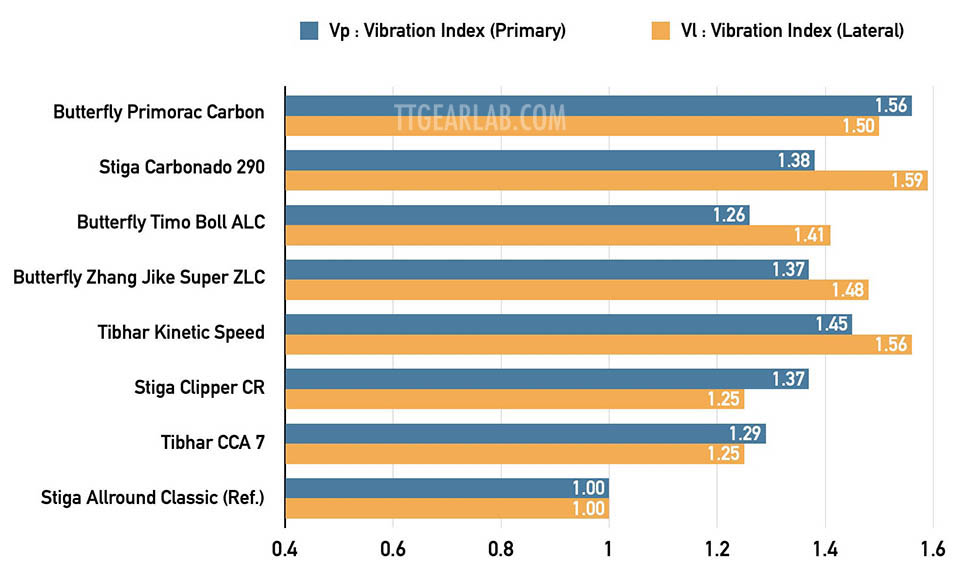
Vibration Indices are concerned with feeling. Vp indicates primary feeling which is transferred to player’s palm. And, Vl is the feeling at the wing of a blade. It is felt by player’s index finger or middle finger.
The Vp and Vl of ‘Primorac Carbon’ are 1.56 and 1.50 respectively. Both of those are very high values. From the graph, we can notice that its Vp of ‘Primorac Carbon’ is the highest among the values of all blades in this comparison. But, Vl is not. It means that the primary feeling of ‘Primorac Carbon’ is harder than any other blade in this comparison but the lateral feeling isn’t. It means that the relative feeling of ‘Primorac Carbon’ that will be observed in next section will be more comfortable than expected.
Among the blades in this comparison, the blade with the second highest Vp is ‘Kinetic Speed’ (= 1.45). But, there is noticeable difference between that value and the Vp of ‘Primorac Carbon’ although it may be considered as small difference for some players. And, the Vp’s of ‘Carbonado 290’, ‘Zhang Jike Super ZLC’ and ‘Clipper CR’ (= 1.37~1.38) are lower than the Vp of ‘Kinetic Speed’. The Vp of ‘CCA 7’ (= 1.29) follows those three, and the Vp of ‘Timo Boll ALC’ (= 1.26) follows it. We can notice that there is big difference between the Vp of ‘Timo Boll ALC’ and that of ‘Primorac Carbon’. ‘Primorac Carbon’ is much harder than ‘Timo Boll ALC’. The difference of 0.3 can be accepted as an extreme difference for many players.
Vl shows different story. The blade with the highest Vl in this comparison is ‘Carbonado 290’ (= 1.59). Although the difference isn’t big, it is higher than the Vl of ‘Primorac Carbon’ (= 1.50). And, the Vl of ‘Kinetic Speed’ (= 1.56) is also higher than that of ‘Primorac Carbon’. The players who are more sensitive to Vl than Vp may feel that ‘Carbonado 290’ and ‘Kinetic Speed’ is harder than ‘Primorac Carbon’.
The Vl’s of two 7-ply wood blades are relatively lower than those of fiber blades. The value is 1.25 for both of ‘Clipper CR’ and ‘CCA 7’. It is noticeably lower than 1.50 which is the Vl of ‘Primorac Carbon’. And, it is also lower then the lowest Vl of fiber blades in this comparison (= 1.41 of ‘Timo Boll ALC’). Therefore, the players will feel 7-ply wood blades much softer than fiber blades if they are sensitive to the feeling that is transferred by the wing of blade. We could have seen many cases that players feel thick/hard 7-ply wood blades softer than ‘Timo Boll ALC’ or other fiber blades. Probably it is because of the relatively lower Vl of 7-ply wood blades when compared with fiber blades.
What is more important is the relationship between Vl and Vp. Examining Vl/Vp will be the better way of comparison. Fig.12 shows the relationship between Vl/Vp and Vp.
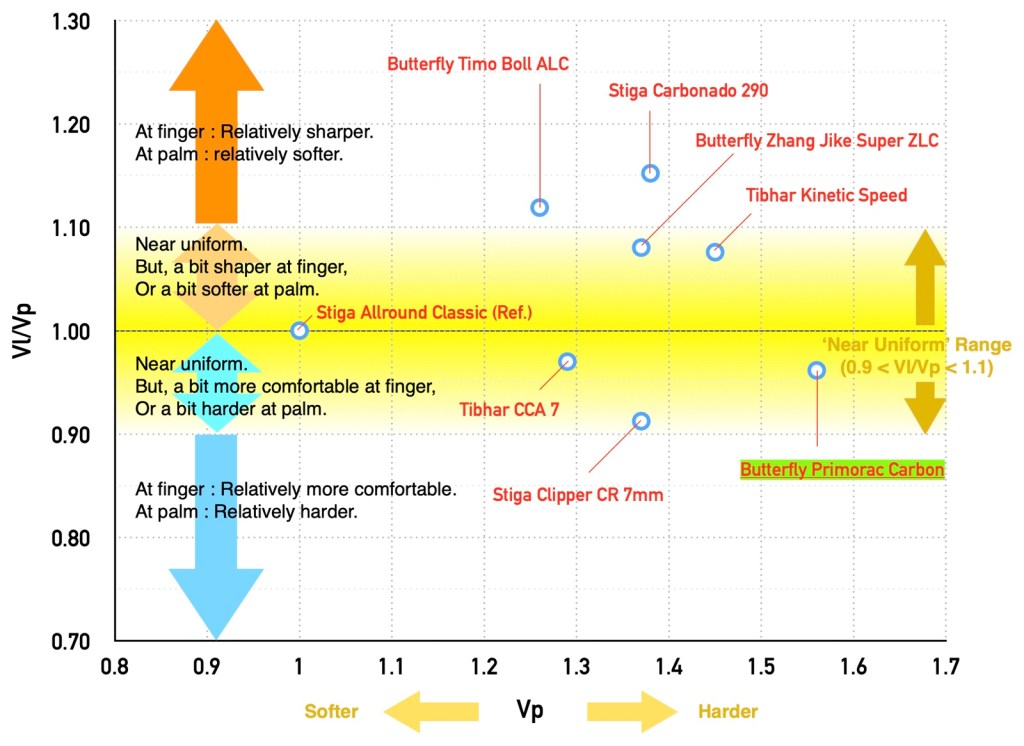
On the graph, the blades in this comparison – except for reference blade any value of which is always 1.0 – can be divided into two groups. Four among seven are placed in upper (Vl/Vp > 1.0) area – ‘relatively sharper at index finger’ range, and the other three are placed in lower (Vl/Vp < 1.0) area – ‘relatively more comfortable at index finger’ range. And, ‘Primorac Carbon’ is in the group of lower area.
The blades those are in the same group as ‘Primorac Carbon’ are two 7-ply wood blades – ‘CCA 7’ and ‘Clipper CR’. The players will feel that the three blades in this group give relatively more comfortable feeling at index finger when compared with primary feeling, although the level of relative comfortability is not big because those three can also be categorized as ‘near uniform (= Vl/Vp is close to 1.0)’ blades.
‘Butterfly Primorac Carbon’ shares basic tendency of vibration characteristics with ‘CCA 7’ and ‘Clipper CR’. It means that players will be able to find similarity between ‘Primorac Carbon’ and two 7-ply wood blades, although ‘Primorac Carbon’ is noticeably harder and faster than ‘CCA 7’ and ‘Clipper CR’. Additionally, all of those three blades are quite thick blades whose thicknesses are over 6.5mm.
The four blades in upper area are relatively thin blades whose thicknesses are in the range of 5.7~6.0mm. The players will feel that those four blades give relatively sharper feeling at index finger when compared with primary feeling.
The result of the comparison between Vl/Vp and Vp is very simple : ‘Primorac Carbon’ is in different area from ordinary ‘thin’ fiber blades, and is similar to thick 7-ply wood blades.
Probably the issue of feeling is the reason why many players who have been accustomed to thin fiber blades such as ‘Timo Boll ALC’ feel that ‘Primorac Carbon’ is strange. However, it is expected that the switching to ‘Hinoki-Carbon’ blades such as ‘Primorac Carbon’ will not be that difficult for the players who have used thick 7-ply wood blades such as ‘Clipper CR’ or ‘CCA 7’.
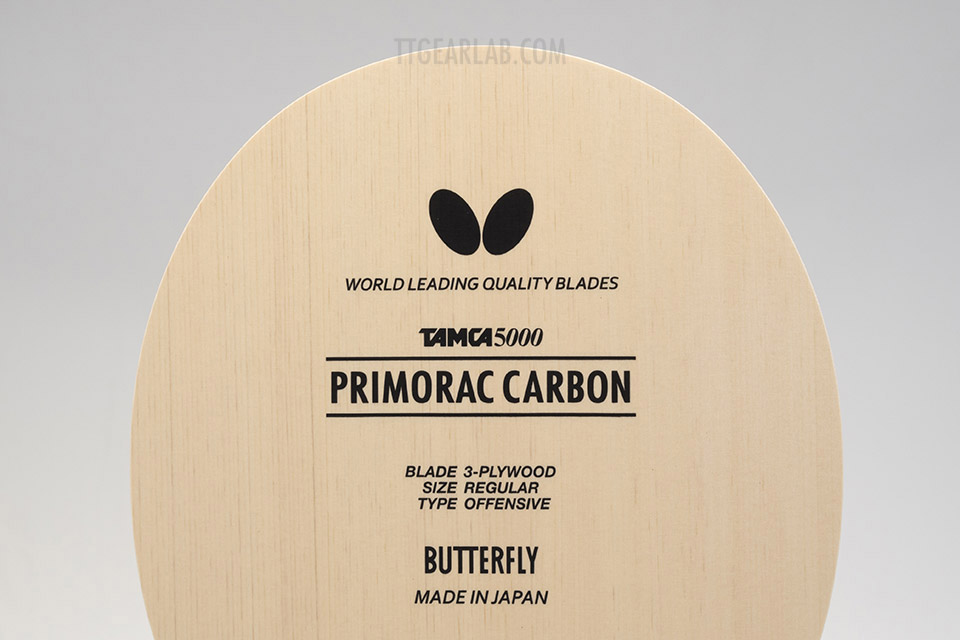
Please click here to return to top (table of contents)
3. Summary
The result of comparison can be summarized as follows :
- The primary elasticity index of ‘Primorac Carbon’ is the highest in this comparison. It means than ‘Primorac Carbon’ is even faster than other famous very fast fiber blades such as ‘Carbonado 290’ or ‘Zhang Jike Super ZLC’. And, the central elasticity index of ‘Primorac Carbon’ is also the highest in this comparison. ‘Primorac Carbon’ is an extreme fast blade in any aspect.
- We may think that ‘Primorac Carbon’ will give very strong additional kick when we hit ball hard with it. However, in fact ‘Primorac Carbon’ isn’t in ‘Kick’ range but in ‘Hold’ range when we observe the relationship between Ec/Ep and Ep. The extreme high elasticity may give players some level of difficulty of control for players who try ‘Primorac Carbon’. However if we can once be accustomed to the extreme high elasticity of ‘Primorac Carbon’, the control of ‘Primorac Carbon’ may become less difficult than expected.
- The primary vibration index of ‘Primorac Carbon’ is the highest in this comparison. The basic feeling of ‘Primorac Carbon’ is harder than that of any other blade in this comparison. Extreme hardness of ‘Primorac Carbon’ may cause problem if players haven’t been accustomed to that kind of hard feeling. However, the lateral vibration index of ‘Primorac Carbon’ isn’t the highest in this comparison. It means that the players who are sensitive to the feeling that is transferred to index finger may feel that ‘Primorac Carbon’ isn’t as hard as expected. For those players, ‘Carbonado 290’ or ‘Kinetic Speed’ may be harder than ‘Primorac Carbon’.
- The overall character of the feeling of ‘Primorac Carbon’ is similar to those of classic thick 7-ply wood blades such as ‘Clipper CR’ or ‘CCA 7’. It means that if the players like those 7-ply wood blades but want harder & faster blade, ‘Primorac Carbon’ can be a solution, and vice versa. However, the character of the feeling of ‘Primorac Carbon’ is fundamentally different from many famous thin fiber blades such as ‘Timo Boll ALC’ or ‘Carbonado 290’. The switching between those blades and ‘Primorac Carbon’ is expected to be very difficult if the players can’t be accustomed to different feeling.
The very hard feeling and the very high elasticity of ‘Primorac Carbon’ are not helpful for the playing style which lays stress on balance. And, if a player want new blade which can replace relatively slower 5-ply wood offensive blades, the speed of ‘Primorac Carbon’ may be too excessive. However, if the player likes hit the ball at very early timing, and doesn’t lay emphasis on spin, the extreme fast blade like ‘Primorac Carbon’ may be meaningful. That kind of playing style has gradually been increasing after the introduction of ABS ball. Of course the probability of end-line mistake may increase right after the change to this kind of very fast blade. But, mistakes can be reduce by the adjustment to new blade through continuous practice. If the player likes ‘high-risk-high-return’, ‘Primorac Carbon’ will be one of the blades those are seriously considerable. And, if the player has used thick/fast 7-ply wood blade, ‘Primorac Carbon’ will be more recommendable.
Please click here to return to top (table of contents)


Please click here to return to top (table of contents)
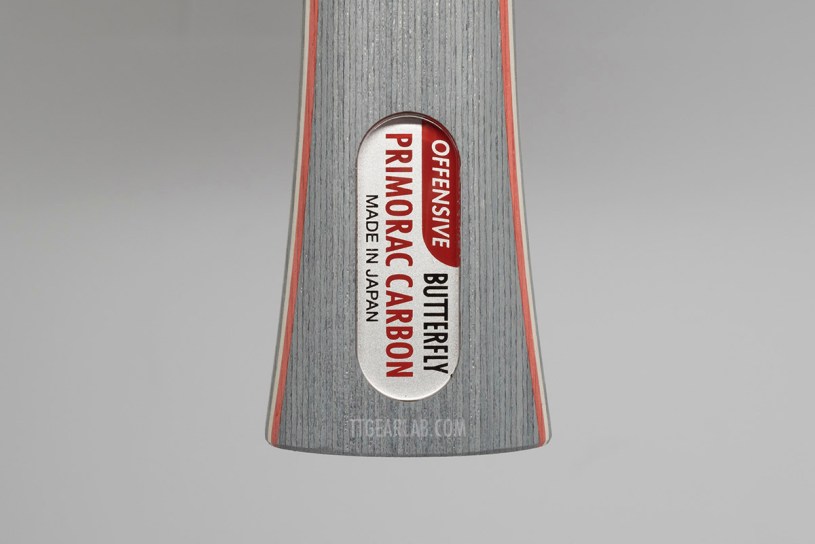
Congrats for your work, I like your approach and find it quite innovative. I would like to ask about a comparison between CCA 7 and other 7-plies and 5-plies all wood blades. Also which indexes in blades are lived by different topspin movement. Thank you.
LikeLike
Thank you for comment. Currently I’m writing an article on a 7-ply wood blade. CCA 7 will be included in that article.
In fact, the performance indices are more concerned with the preference of player than the movement of ball. For that reason I can just say that the relationship between index and ball movement differs by player.
For example, the higher Ep makes more linear ball trajectory in general. But, there are many players who make very dramatic curve of topspin with the blade whose Ep is very high. That is because we can ‘adjust’ our technic to adapt ourselves to the character of blade.
And, to find the best fit blade is very important for some players who can’t easily adjust.
LikeLike
Potresti fare confronto tra Apollonia e innerforce zlc per vedere se sono effettivamente uguali
LikeLike
It is right. (I actually have all three blades – ‘InnerForce ZLC’, ‘InnerForce Layer ZLC’ and ‘Apollonia ZLC’.)
LikeLike
Great job on your page, i played with a DHS Power G 7 and would be grateful a comparison with Stiga clipper CR; also the Loki Arthur Euro or Asia(that use hinoki and ALC) could be similar with the Primorac Carbon.
LikeLike
Thank you for comment! I think that Power G7 can be compared with Clipper CR (new version) in overall performance. But, the player who is using one between two will feel noticeably difference from the other. Power G7 is better for very aggressive close-to-table topspin. But, Clipper CR (new version) is better for modern all-round play.
LikeLike
Dear TTGearLab.com, Hi, This is Ary from @table_tennis_advisory (on instagram). Your reviews are excellent. Do you have any instagram account? Also, could you please make a comprehensive review on Mizutani ZLC (not Super ZLC)? A comparison of Mizutani ZLC, Viscaria, and Apolonia ZLC would be deeply appreciated.
LikeLike
Thank you for comment and appreciation. (I’m sorry that I don’t have an instagram account.)
And, I’m seriously considering the comparison that you mentioned. Currently the problem is that I don’t have good pictures of those blades except for Apolonia ZLC. Probably I will be able to take those pictures in near future.
LikeLike
Hello!
First of all, I want to thank you for the huge work done! This blog contains a lot of useful information and is unique.
But I have a question.
As we see from your research the Ep/Ec of blade Butterfly Amultart is aprox. 1.3 (have strong Kick effect), but Butterfly Primorac Carbon have Ep/Ec = 0.91 (border between Mild Hold and Deep Hold).
The layer structure of Amultart and Primorac Carbon are exatly the same with the exception of Artificial fiber. Does zylon-carbon give such a strong kick-effect than carbon?
I assumed that the core layer matters. Innerforce layer ZLC, Zhang jike ZLC/SZLC (ayous core) Ep/Ec is in Hold side. But Butterfly Jun Mizutani ZLC (Ep/Ec = 0.88, deep hold) as well as Primorac Carbon and Amultart have Kiri core.
What can be the explanation of this difference?
I would greatly appreciate your answer.
LikeLike
After reading this wonderful comparison and test, I now understand why Timo Boll did not use the blade bearing his name and changed to this Primorac Carbon blade during this 2020 Tokyo Olympic Games! The comment “high-risk-high-return” is very accurate!
LikeLike
Thank you for comment. It is a good news that the top players are interested in this kind of thick & fast blade again.
Primorac Carbon is a blade that was also developed for top players. And, the table tennis will not be interesting if all players are using Timo Boll ALC, Hurricane Long 5 or the blades similar to those two. 😉
LikeLike
Do you think this blade can be useful as easy to use blade for short-stroke allround style combined with classic non-glue effects such as Sriver, Mark v or Musa, in case I do not like the artificial feeling of tensor rubber?
LikeLike
Hello.
Congratulations for your good work.
Primorac carbon is a head heavy blade?
Thanks.
LikeLike
I think that Primorac Carbon isn’t especially head heavy. But, if the weight is over 88 gram, it will become head heavy.
I remember that Zoran Primorac had always selected 86~88 gram.
LikeLike